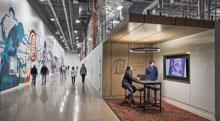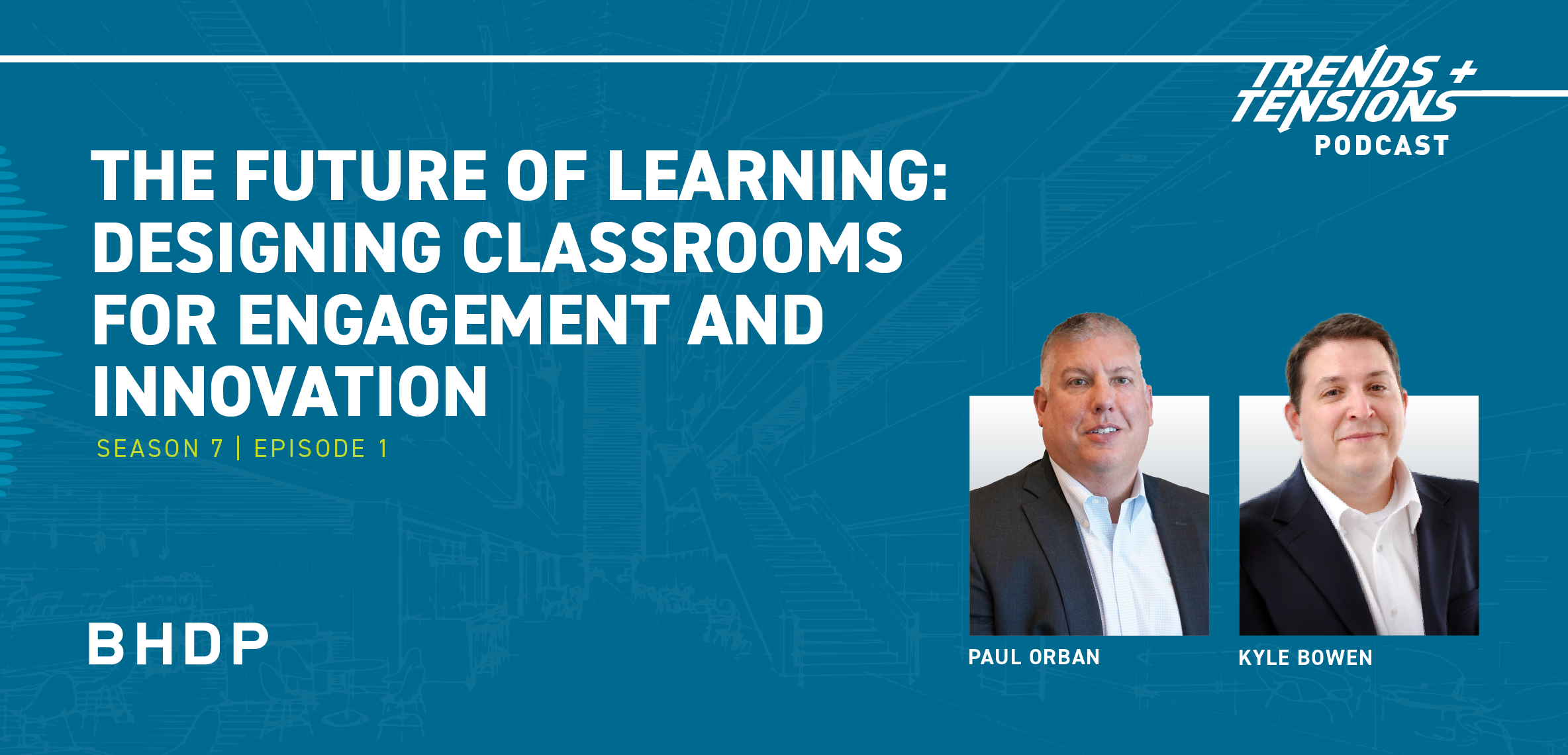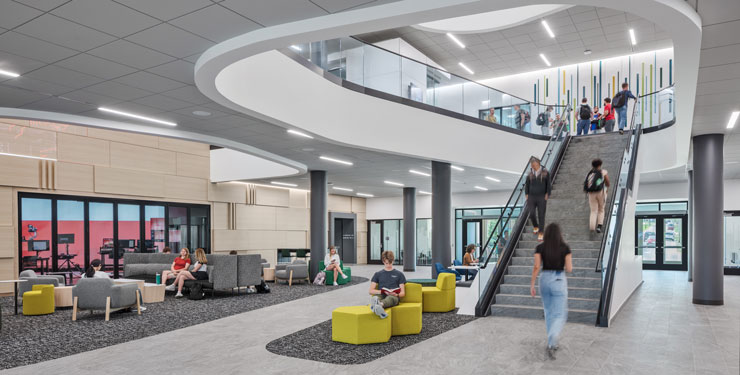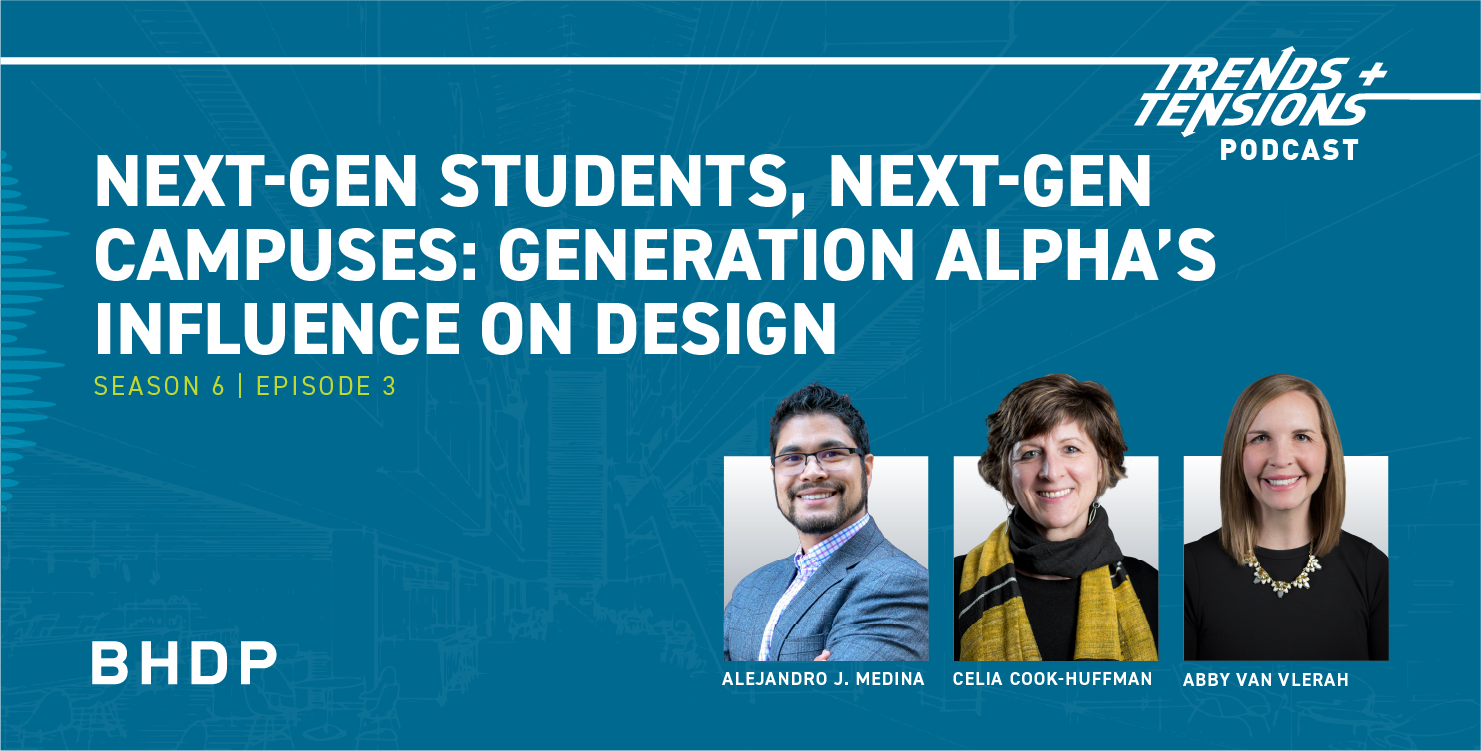
The Future of Learning: Designing Classrooms for Engagement and Innovation

Want to listen on another platform? Choose your platform here.
Episode Transcript
[Music Intro]
Brian Trainer, Host: Welcome to Trends + Tensions in Architecture and Design, presented by BHDP, where we discuss Trends in Architectural and Interior design and the competing priorities or Tensions that arise from integrating new ideas into existing organizations, enterprises, and institutions. In this episode, “The Future of Learning: Designing Classrooms for Engagement and Innovation,” we are joined by Kyle Bowen, Deputy Chief Information Officer at Arizona State University, and Paul Orban, Managing Partner at BHDP. I am your host, Brian Trainer, senior strategist for BHDP. Let’s get started. On this edition of Trends + Tensions, we're going to be talking about emerging trends in academic spaces, about integrating pedagogy, space and technology together. Our first guest, I'm going to give you a chance to tell us who you are and what you do and then what attracted you to this topic. So Kyle, if you would tell us who you are and what you do.
Kyle Bowen: Hello, my name is Kyle Bowen. I'm the Deputy Chief Information Officer here at Arizona State University. I have an exciting role where I get to collaborate with faculty, leaders, and students across the university to imagine what the future of our learning experiences can look like.
Brian: Fantastic. Thank you, Kyle. And our other voice you'll hear today, Paul, tell people who you are and what you do.
Paul Orban: I lead the higher education practice for BHDP. You know, I'm personally interested in this topic because as we're out working with. Many of our clients coast to coast on helping them envision the next generation of learning spaces, campus spaces for students.
We see a lot of people struggling with aged learning environments, especially the independent smaller campuses where they may not have the budgets to continuously improve these spaces. And so I think there's a huge need out there to help reimagine learning spaces beyond just the space, but including the technology and how people are going to teach in them and excited to try to help solve the problem.
Brian: Thank you, Paul. And Kyle, back to you. What draws you into integrating pedagogy, space and technology?
Kyle: You know, I think it's one of those things where when we imagine our college experience, so much of it is in the classroom, right? That relationship or that engagement we have with an instructor or the relationship or engagement we have with our fellow students.
And really, you know, part of it is, is that the space we work and learn in matters a great deal. And so part of it is that rather than having kind of a one size fits all strategy to space to really think about how do we design space that, you know, enables teaching and learning in the ways that our faculty are engaging and designing for and in the ways that in which our students can learn effectively. And I think that's where, you know, I'm so struck by the power of space and even how small changes can make big differences in terms of how people learn inside of their spaces.
Brian: What is it about the current campus situation, the physical spaces that are most important to students?
Kyle: A big part of this is around diversity and having a lot of different options because, essentially, learning doesn't look the same way all the time. And I think what we need to do is kind of move away from the idea that classrooms are like a train schedule. That train is always going to arrive at the same time, and it's always going to kind of look the same way, and I'm always going to have the same seat, whatever that is. I have different needs based on what I'm trying to accomplish, whether I'm collaborating with another group of students, whether I'm working on a group project, whether I'm interacting with digital media, or maybe creating something.
So, part of what we do is redefine what we think of as a learning space so that it's not just classrooms but rather the entire spectrum of spaces where students interact in collaborative spaces, how they interact outside and how they interact inside the digital environment.
Paul: So, thinking about the entire spectrum of space where students kind of occupy and collaborate and work the pandemic from an architectural and planning standpoint on campuses. One of the things the pandemic emphasized for us was that students have this desire to be together and learn collaboratively. There was this thought that because they were forced to learn online, it would stay that way, and that would be the future, and the campus would not be relevant. The reality is it emphasized that it really is relevant. Students are hungry for these environments. What stood out to me was that, you know, we recently conducted a national survey of chief academic officers that revealed 64 percent of them responding said their campus was set up for a traditional lecture hall format. However, at the same time, we all know that's the least effective teaching practice.
On the flip side, they said that active learning is the most effective environment for them, yet only about 40 percent of their space may be able to support that format. So, there's an issue there we need to solve. And many of these campuses just aren't set up to teach in the most effective way and in the way that students want to be better prepared for their next academic or professional career.
Brian: If we have these campuses with those more traditional classrooms and lecture environments, Kyle, you mentioned digital. From an infrastructure standpoint, what challenges are you facing in upgrading those types of spaces to serve a broader population?
Kyle: Yeah, well, that's where, over the last several years, we've focused very heavily on kind of transforming our spaces to enable the kind of digital experience inside of those classrooms that our faculty and students come to expect the idea being that the digital capability of a classroom shouldn't always be this kind of additive idea where there's a new piece of equipment that needs to be kind of bolted on to provide new capability. And that's where partnering with colleagues like Zoom to kind of integrate software solutions into the classroom to enable new collaborative capabilities, enable our faculty to extend their classroom outside of the physical space, but then what it does is it allows the classroom to have new digital capabilities through software updates. And so, if you think about kind of the same way that Tesla owners can get and download upgrades to their car is the same way that our classrooms can kind of get updates to their classroom and provide new capability through that.
So I think that's one of those things where, as we design new spaces and rejuvenate existing spaces, we should think about, "What is that digital experience, and how can we simplify it?" So again, we should avoid the pitfall of thinking, "Oh, well, a lot of technology is good." Rather, what is the right solution for those classrooms?
And what we're finding is that having a fairly simple, streamlined classroom that automates as much as possible but also takes into account sound control, takes into account lighting, takes account the placement of displays around a room so that there aren't too many, but there are enough. Is a big part of, you know, creating this really great kind of digital experience that unfolds inside the classroom.
Paul: It's been this bolt-on approach. So many of the classrooms that we see in reality, the box, per se, the learning environment, is the same box that it was in the 1950s and 1960s. In fact, many times we're still seeing that furniture and dated era of interior environment. With the exception of there's been a monitor added to the wall or a projector or a teaching podium to add that technology. And, you know, the reality is, it just continues to kind of layer into that space. But the space just isn't as effective because you can't use modern furniture. You can't space students out for group learning. You can't do breakout groups as easy, you know, in a day when campuses need to be very budget-sensitive and maximize every asset they have, including classroom space. You know, we're starting to see that they're just not as versatile as they need to be. And I love the idea that Kyle talks about of this more streamlined, simple approach to technology because it really heads down that path of how can these spaces be used more because they're, nimble, right?
They're flexible from technology. I think one of the challenges that we see out there in talking to leadership on campuses, you know, a recent conversation with a college president of a small independent residential institution was talking to me about their budgets and just maintaining the IT infrastructure, you know, including the hardware and software is, a major cost in their annual budget, let alone trying to upgrade and change. So, by adding so many tools, they've actually hurt themselves because they have a lot of things to update, right? So, you know, is this idea if we start to peel the layers back and create a more simple approach that can be updated as Kyle speaks to, I think ultimately would help the bottom line of these institutions and therefore allow them to invest in other important things.
Kyle: We've been focused really in the last couple of years on, you know, how do we create spaces that are more collaborative, right? And if we think about that as our goal of thinking about the student-to-student interaction, thinking about the student-to-instructor interaction, and recognizing that that can happen in a lot of ways. But what we want to do is create the greatest degree of flexibility. But to do that in spaces that are common inside of our space catalog. So, if you look at the strata of different spaces that a university has to offer, you know, you have a few at the high end, right? And then it comes down into a long tail of spaces that are in that kind of 25 to 30 student size classroom.
The goal is to say, “Hey, what does a collaborative space look like in that space?”, thinking about 25 to maybe 40 students, small to medium-sized collaborative spaces, and that's one of those things where we've put a lot of work into designing spaces that could be hybrid but also enable flexibility so that they could have different seating formations. The other part of that is having an abundance of writing surfaces. Gosh, you could never have enough writing surfaces, right? Whiteboards, to the greatest degree possible, that are both flexible, usable, and accessible, are critical around that enhancing collaboration in the classroom. And I think the last thing that we've really begun to integrate into our classrooms and have found some success with is really thinking about how do we meet the needs of all of the learners inside of our space?
And as we looked at how students come into spaces and how they exist while they're there. What we find is, is that students have different needs when that classroom becomes more active, you know, that can be a challenge for some students, right, whether it be that it becomes a sensory challenge, or it may be that they have a different set of kind of physical needs, and so that's where, you know, one of the things we recently developed is something we call an anchor space, and the idea is that this is a space that is always right inside the door because what we found is, is that sometimes our students, when they come in, say, with a service dog, or something like that.
They're not quite sure where to go in the classroom, particularly if it's flexible. That means the chairs have moved around, and so they often have to wait in the doorway for somebody to help them find a place. So we defined a space that never moves as an anchor space. It's always right there, so when you come in, you can come right to that anchor space. But the other part of it is, for students, when we have a collaborative experience in their group work, and they need to kind of step away for a quick break or something, right? That anchor space serves that same kind of need. And it's a very simple change, it's basically one small bench, it's right next to the door.
But it created so many different options for how we could help enable students in new ways. So, I think we need to spend more time designing and focusing on how we meet the needs of all students when they think about, well, who was this classroom designed for? In the past, it's historically been, well, nobody in particular, right? But, now it should be, no, it was designed for you. And it's through these kinds of small changes that will help us kind of innovate space over time.
Paul: Yeah, I was just going to say, I think it really starts to speak to a collaborative design process that yields a collaborative teaching and learning environment. What Kyle's describing here comes back to really, truly understanding the uniqueness of that institution, their students, how they're going to teach, and what they need versus just saying, Hey, this is how we've designed a classroom, you know, for the last 20 years on every campus. So it's one size shoe fits right? Ultimately, it's the details that it is that make the difference, right? That space that Kyle's describing that's consistent in every room, the way the technology operates consistently in every room. So, faculty, you're reducing stress, you're reducing that energy that could be lost on trying to figure this stuff out so they can concentrate on what's important, the reason they're there to teach, to learn, to collaborate.
I think one of the challenges we see out there is in existing classrooms. We're talking about walls that may be fixed, and the box is only so big. It was set up originally for more lecture-style teaching, so you're talking about maybe 20 SF per student aggregate in that room. What we really need to be pushing for is 32, 35 plus SF per student to get more to active learning or a room where we can move around and we can leverage the teaching walls. So, how do you do that? And that seems to be one of the challenges that a lot of our clients are running into. And I think the answer to potentially unlocking that solution lies in utilization because if we have a lot of underutilized space right now, we can convert that to higher-used space. That means we may have extra space. So, we can start to take down walls. We can make these classrooms larger because maybe we need fewer of them. We can use them more during the day and schedule them higher. We can also allow some of these great features like Kyle's describing to fit inside that box and create that modern classroom.
Brian: If you were going to a campus administration and telling them, Hey, you need to allow for more SF per student in order to get to higher utilization. Like, how do you make that argument?
Paul: I think one of the ways to get there is to do a utilization study of how those classrooms are scheduled and show them. And when you come back in, the reality is you're finding classroom spaces that are 30, 40, 50 percent utilized on a given week. And you're saying, you know, this could be 60, 70, 80 percent utilized with some modifications.
Brian: Kyle, it sounds like you have really dove into the neuro-inclusive design and, in a really simple solution, that anchor space. Are there any other moves like that that you've done?
Kyle: Part of it is to find, like, what are the options that work? Or, as I'm fond of saying, students vote with their feet. And so, what are they making use of and finding value in? Another example is that collaborative spaces that we have across the university, you know, collaborative spaces are often put into atriums and places like that because, you know, they're visually very appealing. They have kind of a spaciousness to them. You can put a lot of people in them and be very flexible about it. But at the same time, as we talk to students, they also feel very vulnerable in those spaces because, essentially, they're kind of sitting inside what feels like a fishbowl, right? Like I'm in the middle of something where there are a lot of people moving around, there are a lot of things happening.
We've been experimenting very successfully with creating what are effectively little tents that exist inside the space. These tents have a single workspace, and the student can go into that space and work. They're portable and usable, and they've been incredibly popular in our atrium spaces. Those are often the very first spaces consumed by students, and we have them both for individual students or for small groups. So if you have a group of, say, four or five that want a space to work inside a big area like that, you can collaborate, you can work together, but you don't feel like your voices are filling the entire space. You feel like there's a monochrome of kind of privacy to that, and it gives you kind of a place to be. I think there are these kinds of things where thinking about how do students kind of want to use spaces, but what are maybe some of the challenges that they're having that they're not necessarily able to easily express. Or maybe they don't know what the problem is or what potential solutions are. Because essentially, if you think about the atrium as, like, what student comes in and is like, "Hey, can you put a tent over here?" It's not going to happen, right? So, part of it is to really understand, like, okay what are the barriers to effectively using this space and how can we get really creative about supporting our students in new ways?
Paul: How are you measuring the success of your learning environments and incorporating that feedback into your process to evolve what you're going to do next? I'm always interested in engaging the users, the students, to get that feedback, and then how does that influence your next changes?
Kyle: So, when we start to kind of incorporate feedback into design, that's where faculty and students are critical to that. We want to create innovative ways of capturing that feedback. Of course, we all do surveys and things like that, but they rarely have the level of fidelity that we really want to help us understand. Like, no, really, what is it? That would really improve the space. And so that's where we've developed a couple of strategies. One with students: We'll take and put the specific furniture pieces in student common areas to see how students interact with them. Then, we'll ask students how they feel about this particular chair or table or whatever the case is. And so it's a place, a way to kind of experiment with it.
We've also done, you know, studies where we'll outfit through a renovation project. You know, classrooms in different configurations to see how it is in using different pieces and different pieces of tech to see, you know, how are the faculty-student interactions kind of aided through that process and using that to form further design decisions. But I tell you, the one that really is the most compelling is a process we've designed. It's a process we've designed to capture feedback from faculty as they're using a space. And we use this to evaluate, usually, you know, experimental designs or new designs. A faculty member, right after class, they'll get a text message asking them, hey, you know, how was class today? How did you use technology to engage your students in a new way? And then they can just text it back. Or, in some cases, actually, they record a little video and send the video back. So, what this does is it captures at the time they're thinking about it but to do it in an unobtrusive way. And it also does it over time. That not only captures the feedback but then roots it in a reflective teaching practice. So the instructor thinks about, well, oh yeah, how did I use the space? What did work well there? And then, as things are not going well, they can put that in the feedback, and then we can get it immediately.
So, if something's not going well, we don't have to wait until the end of the semester for it to show up in a survey. It's like, oh, turns out whatever that thing was, does it work? So, let's go ahead and get it swapped out now. Right? And, so it creates this really great model where we're getting feedback, we're getting it as it's happening, and we can kind of make adjustments and changes along the way. But we also get to see it over the arc of a semester so that we can see, hey, how this configuration worked, whether it be as part of a different style of class, whether it be a group project, a lecture session, or maybe it's a testing session, right? What's working, not working over the whole of a class, not just one snapshot in the middle? So I think that's where you have a really innovative approach to soliciting feedback more than just kind of surveys and focus groups, but things that kind of capture as it happens go a long way towards helping kind of draw out like, okay, what are the real opportunities in design here?
Brian: How long have you been capturing data like that? Is this a recent discovery or have you been doing it for several years now?
Kyle: I would say two or three years. And essentially these are part of kind of like targeted initiatives to say, okay, we want to understand for this particular. You know, like, for classrooms that are, let's say, you know, 30 students where we want to design them to enhance collaboration in a particular way. We have a collection of faculty who are looking for classrooms that support that type of interaction. So, we kind of marry the design with the pedagogy and the instruction and then capture and understand, okay, is it achieving its desired effect in terms of the feedback from the faculty and also in terms of feedback from the students? If we have good success in that, we will take those designs and proliferate them into other spaces on campus.
Brian: So, how are AI and other emerging technologies starting to impact the design and use of campus learning environments?
Kyle: Well, you know, and I think we're just at the forefront of the changes that are coming to the classroom, right? And that's where, again, there are things we can look at in terms of automation, in terms of the classroom, in terms of automating some of the audio-visual interaction or automating your camera controls or microphone controls, these kinds of things. So, kind of the edge technologies, we might call them and the ways that AI are kind of enhancing things there. I think that's on a spectrum, though, of as we, you know, for example, capturing telemetry from the classroom, and I think this is kind of the next generation of it. Imagine the classroom is kind of like a smartwatch for teaching, teaching, and learning where telemetry from the classroom gives an indication of how people are interacting and gives feedback or insight to instructors in terms of, hey, here's how students are kind of interacting or making use of space.
And that's again a combination of movement, it's a combination of sound, it's a combination of you know, the words that are being used inside of the classroom. This is the evolutionary change. I think that beyond that is really, again, thinking about classrooms not just as a physical space. Only or a physical location only, but rather in themselves, a cloud location that the entire space exists in a cloud environment so that it has, you know, this information can be captured in a very ambient way. So that they're no longer thinking about, you know, well, I have this recording, and it's sitting on this computer, or whatever the case is, but rather the classroom has captured this experience or the classroom has provided a certain amount of information. I think there's another piece of this, which is thinking about localized AI so much right now, we have these large language models that people are making use of and doing incredible work with. But part of it is also if we imagine language models designed for classes where, through communities of interaction, they're effectively building their own language models inside of those classes.
And so effectively, we have this new type of insight that can be created. Because the classroom or the space or the virtual space online becomes that common thread, that point of the community, then we can begin to develop a common language model that surrounds a class. So I think that's kind of getting further into the future. So, I think there are many ways that AI will continue to manifest.
Paul: The interesting thing there to me is, this is a case in terms of campus planning and design where the technology's gonna lead us more down the road of what do spaces need to enable and support, right? And, as I envision, you know, some of the concepts Kyle's talking about, it really accentuates this fact that the learning, the classroom isn't just inside these four walls and a door that that classroom could be anywhere on campus.
So, you start to think about the entire campus as the learning environment because that technology truly becomes mobile, right? And a full sense of the word compared to what it has been in the past. You know, right now, mobile technology, it's in your pocket and your cell phone. But, you know, as we start to think about how could every environment on campus really become that potential classroom depending on, again, the needs of the airplane gate, right? To use Kyle's analogy, we can start to vary that based on the daily needs and the real-time needs of the student
Kyle: You know, that's a really important point. If you look at any particular class, their pedagogical needs for the classroom are not the same for every class meeting. Right. And so part of what we need to do is challenge the assumptions that we've historically made that a classroom is always the same room, a classroom is always the same instructor and a classroom is always the same collection of students at the same time and place. These things aren't necessarily required anymore.
And so rather having classrooms that reflect the needs of the class for, you know, whatever the pedagogical goals are for that activity and to provide a greater degree of on-demand type of capabilities. And so that ability to kind of seamlessly move between space, but yet be able to persist the shared elements of that class meeting, I think, is really ultimately where we're headed. It's less so, hey, this is my classroom, and it's always this room, and rather no, for these class periods, I have a different set of needs. And so, we're going to kind of make use of different spaces as a result.
Brian: What do you envision as the ideal campus learning environment to support the needs of the next generation of students?
Kyle: I think that thinking about that future is a challenge because I don't think it's one thing. I don't think there is an ideal. There are many ideals and that's, and that is the interesting opportunity, which is not having kind of one-size-fits-all experiences, but rather having a lot of options that reflect the diverse needs of our students that reflect the diverse needs of our faculty, that makes it easy. To have those kind of engaged experiences, right, that make it easy for students to develop those kind of authentic relationships inside the classroom, to have spaces that are accessible, that reflect the cultural values and diversity of our students who use them, and that's, I think, a tall order, but it's also where we need to get to, and that's where the opportunity is for technology to be an affordance in doing that.
And when I talk about technology, I don't necessarily always mean digital technologies, right? It could be the analog physical things inside of the classroom. I mentioned, you know, writable surfaces earlier. You know, wheels on chairs was an incredible pedagogical innovation. And so, you know, these are things that we need to kind of keep an eye on, but also imagine even far more advanced digital environments. You know, one of the technologies we have here at Arizona State University is something called Dreamscape Learn, which is a reimagining of using virtual reality to reimagine what a biology experience looks like. Or what does the chemistry experience look like? Or what does the art history experience look like?
And these are, you know, not your traditional virtual reality experiences because, normally, they are fully immersive, but they exist in the context of a space. And that is actually a cloud experience. And yet you're I'm having a cloud experience, and it's all inside of a shared space where I'm engaging in a story narrative. And so, I think part of this is how we change how we think about what content is in the space. And it's not just an instructor or a video or something delivering content, but rather, I'm existing as part of the narrative. And I think that's where, as we reimagine that future, it's around having far more options in terms of how I can make use of a space that reflects, as an instructor, you know, kind of the pedagogical approach I want to take. But then as a student, how are my learning needs best being supported?
Paul: I think what Kyle describes is awesome from a learning environment. I mean, I think creating environments that students want to be in every day, and in leverage, and, and really feel like they're effectively learning. You know, the faculty enjoy teaching in those spaces. It's important ultimately, as Kyle said. You know, like the analogy, students vote with their feet. I hope that as these evolve, they help many of our clients out there in higher education, especially smaller schools, recruit and retain because they just help promote the fact that it is important to be together to learn when they can be, but they don't always have to be right.
Therefore, it opens the doors for people who aren't on-campus necessarily to learn and engage so that we include a larger student body, right? Ultimately, I think that'd be great for all of higher ed.
Brian: So, what are suggestions in terms of the next steps? You know, what do you want people to think about when they're designing these learning environments?
Kyle: I think the number one, you know, recommendation I always make is around engaging with students, engaging with faculty, and doing that through more than surveys and focus groups. Finding ways to kind of get that feedback, get that insight into how people feel in spaces, what is it that they're looking for? What are the struggles that they find? Every instructor can share with you, you know, the struggles they've seen students have, and so part of it is to engage and listen to those stories. And then think about, like, how can we come up with systematic approaches to addressing some of these needs?
And sometimes, the smallest changes can have the biggest impact, but it's only through listening to those stories, seeking that feedback, creating experimental spaces for people to try new things, and creating places for students to get hands-on with new ideas that we can continue to shape this because it's not a one-and-done activity.
So this is not something where, gosh, we'll come up with whatever the perfect classroom is and then just create a bunch of those. This is an enduring commitment to continually evolving what our learning spaces look like, and so part of it is just to normalize that activity of learning how people are working and learning inside of the space and then continually improving over time.
Paul: Yeah, I would like to add. I love the idea of engaging faculty and students in real-time. You know, I agree with Kyle. It's very valuable feedback on what's working right now. What's not working right now? Why? What can we do to make this better? What if we did this right in that real-time atmosphere? You know, I think the other thing would be clients understanding what do you have today? You know, from that audit standpoint, right? Does everyone understand what you have in terms of classrooms, type, size, capability, technology, you know, audit as well at the same time because they go together? And then stepping back to say, what can we do to simplify this? You know, what can we do to start to move in a way that is more user-friendly and also easier to maintain and more flexible and adaptable, as Kyle described earlier?
I think that audits can be done relatively quickly and efficiently, especially with an outside set of eyes to say, "You know, there are some things here we see that may not be working as well as they could be." And then how do we design a solution tailored for that specific context, that client, and what they're trying to do?
Brian: Thank you both for your time. Hopefully, this has been entertaining. I appreciate your time today. Thank you.
Paul: This is great. Thanks so much for doing this, Kyle.
Kyle: Of course.
[Music Outro]
Brian: Thank you for joining Trends + Tensions in Architecture and Design, presented by BHDP for this episode, “The Future of Learning: Designing Classrooms for Engagement and Innovation,” with Kyle Bowen of Arizona State University and Paul Orban of BHDP. If you appreciate what you have heard, please rate, subscribe, and give us a review.
I am Brian Trainer, your host, and I hope you’ll join us for another episode of Trends + Tensions to see what topics drive design.
Author
Content Type
Podcast
Date
January 29, 2025
Market
Practice
Topic
Campus Planning
Innovation




